 Galatea as seen by Voyager 2 (smearing has caused excessive elongation) | |
| Discovery | |
|---|---|
| Discovered by | Stephen P. Synnott[1] and Voyager Imaging Team |
| Discovered in | July 1989 |
| Orbital characteristics[2] | |
| | |
| Semi-major axis | 61 953 ± 1 km |
| Eccentricity | 0.00004 ± 0.00009 |
| Orbital period | 0.42874431 ± 0.00000001 d |
| Inclination | 0.052 ± 0.011° (to Neptune equator) 0.06° (to local Laplace plane) |
| Is a satellite of | Neptune |
| Physical characteristics | |
| Dimensions | 204×184×144 km (±~10 km)[3][4] |
| Mean radius | 88 ± 4 km[5] |
| Mass | 2.12 ± 0.08 × 1018 kg[6] |
| Mean density | 0.75 ± 0.1 g/cm3 |
| Rotation period | assumed synchronous |
| Axial tilt | ~zero presumably |
| Albedo (geometric) | 0.08[3][4] |
| Surface temp. | ~51 K mean (estimate) |
| Atmosphere | none |
- There is also an asteroid called 74 Galatea.
Galatea (pronounced /ˈɡæləˈtiːə/ GAL-ə-TEE-ə, or as in Greek Γαλάτεια), also known as Neptune VI, is the fourth closest inner satellite of Neptune. It is named after Galatea, one of the Nereids of Greek legend.
Galatea was discovered in late July, 1989 from the images taken by the Voyager 2 probe. It was given the temporary designation S/1989 N 4[7] The discovery was announced (IAUC 4824) on August 2, 1989, but the text only talks of "10 frames taken over 5 days", giving a discovery date of sometime before July 28. The name was given on 16 September 1991[8].
It is irregularly shaped and shows no sign of any geological modification. It is likely that it is a rubble pile re-accreted from fragments of Neptune's original satellites, which were smashed up by perturbations from Triton soon after that moon's capture into a very eccentric initial orbit.[9]
Galatea's orbit lies below Neptune's synchronous orbit radius, so it is slowly spiralling inward due to tidal deceleration and may eventually impact Neptune's atmosphere, or break up into a planetary ring upon passing its Roche limit due to tidal stretching.
Galatea appears to be a shepherd moon for the Adams ring that is 1000 km outside its orbit. Resonances with Galatea in the ratio 42:43 are also considered the most likely mechanism for confining the unique ring arcs that exist in this ring.[10] Galatea's mass has been estimated based on the radial perturbations it induces on the ring.[6]

0 comments:
Post a Comment